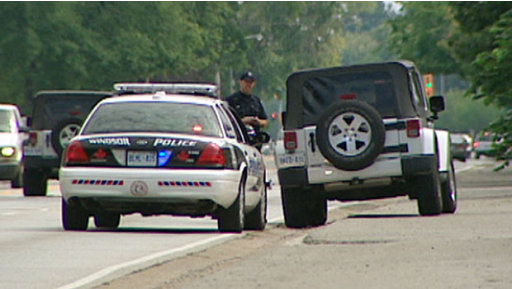Windsor, Ont., has the second highest number of speed traps in North America, according to the National Motorists Association.
Windsor is the top Canadian city, second only to Livonia, Mich., in an annual list of the top 25 cities with speed trap locations, based on a per capita ranking.
Gary Biller, executive director of the National Motorists Association, said it isn't a definitive survey and that the informal ranking is based on the number of people reporting speed traps on the organization's website.
"Coming up to the Labour Day weekend people kind of check their travel routes a little bit more and again, drivers who can anticipate rather than react suddenly noticing a police cruiser on the side — it's safer for everybody to do that — so it's more of a public awareness feature," Biller told CBC Windsor's Early Shift host.
Biller identified Dougall Avenue near the southwest end of the city as the spot where police camp out the most. The National Motorists Association is based in Wisconsin.
Brian Ducharme, a lawyer who defends people charged with speeding, agrees that Windsor has a lot of speed traps.
"I see the police using black unmarked pickup trucks which is not typical of police and as a result I see them stopping people," said Ducharme.
The city gets a share of speeding ticket revenues but the police don't, said Police Chief Gary Smith.
Smith said they're not under any pressure to step up enforcement to make more money and he doesn't believe police are overzealous. He said they stake out areas where speeding occurs the most.
"We try to match our enforcement to high accident areas or where the speed is just ridiculous," Smith said.
Smith said enforcement is only up two per cent over last year and the police haven't received any complaints about speeding tickets.
"Fatal accidents — last year I think there were only two. We were only one this year. Our total persons injured as a result of motor vehicle collisions is down 25 per cent," he said.
But Ducharme still believes the speed limits in the city are pegged too low.
"I see some areas where they've reduced it from 50 [km/h] to 40, so that's too low," Ducharme said.
Smith said speed limits are slower in places because of school zones or reduced visibility on the roads.
------------------------------------------------------------------------------------------------------
------------------------------------------------------------------------------------------------------
1. In Canada, traffic regulations are made at the provincial level. But contrasting laws in Quebec have caused one the province’s highest-ever traffic fines to be issued. Charles Duguay, who lives in Sherbrooke, Que., was issued a $718 fine and 10 demerit points in early 2008 after police nabbed him driving 122 km/h over Montreal’s Champlain Bridge, which has a limit of 70 km/h. Duguay claimed, though, he shouldn’t have to pay the penalty because there are two sets of traffic laws on the province’s books. The initial fine was issued under Quebec’s recently amended traffic laws. But the old traffic fine structure is still in effect, because the amended law did not rescind previous rules. Under the older law, Duguay would be fined $250 and five demerit points.
2. British constabulary probably thought they were having a good day when they pulled over a driver doing 185 km/h on rural roads. But the big score came when a second speeder was clocked doing a 24 Hours of LeMans-like 276 km/h in his Porsche 911.
Generally, speeders caught on the United Kingdom’s speed cameras get a $100 fine. But the Porsche driver was slapped with $1,250 in courts costs and 10 weeks in jail. And the fines didn’t end there. Like many European countries, U.K. law permits speeding infractions to be determined on a sliding scale based on driving conditions and how fast the driver was travelling above the limit. Thus, the police added charges of careless driving, bringing the total to $9,250 — plus the jail time.
Generally, speeders caught on the United Kingdom’s speed cameras get a $100 fine. But the Porsche driver was slapped with $1,250 in courts costs and 10 weeks in jail. And the fines didn’t end there. Like many European countries, U.K. law permits speeding infractions to be determined on a sliding scale based on driving conditions and how fast the driver was travelling above the limit. Thus, the police added charges of careless driving, bringing the total to $9,250 — plus the jail time.
3. In 2008, a 31-year-old resident of Hinton, Alta., was stopped on Highway 16 between Edson and Hinton, about 280 kilometres west of Edmonton, driving 263 km/h — 153 km/h above the road’s limit – on his motorcycle. The judge hearing the case let the motorcyclist keep his license, as long as he paid the $12,000 speeding ticket – one of the most expensive speeding tickets ever issued in Canada. The same traffic court handed a 25-year-old from Prince George, B.C., an $8,500 fine for driving his Chevy Cobalt 206 km/h along the same stretch of highway.
4. The Finnish government started basing its speeding fines on net income about a decade ago. Police can access a citizen’s income tax records via their cell phones, and issue the corresponding traffic fine on the spot. Keijo Kopra, a wood products company executive, received one of the first tickets under the new law. In November 1999, on his wayhome from work, he was caught driving only 22 km/h over the speed limit. Dialing up his income information, the officer wrote him a ticket for $14,500. In court, the judge lowered it to $9,000. Then the arresting officer mentioned that Kopra had two previous speeding tickets in the same year before the new system went into effect. Based on the new income-based laws, the judge imposed additional fines of $38,000.

No comments:
Post a Comment